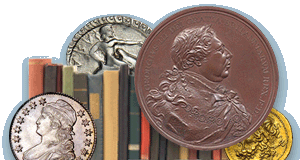
PREV ARTICLE
NEXT ARTICLE
FULL ISSUE
PREV FULL ISSUE
VOCABULARY TERMS: CAST AND CHASEDDick Johnson submitted these entries from his Encyclopedia of Coin and Medal Terminology. Thanks. -Editor
Cast and Chased. Molded pieces which are subsequently hand worked to sharpen molded relief and infrequently to add engraved lines. This is a method of producing medals (other methods are striking, repousse, niello). Casting and chasing is particularly useful for creating large medallions – and was the method employed by the first medalists of the Renaissance, by Pisanello and others who followed him. The larger the cast medal or object the greater the need for chasing. Casting by its nature has certain imperfections, both raised (as lines, burrs and bosses) or incised areas (pits, holes and nicks). The imperfections may be in the mold or in the piece cast from the mold. Trapped gasses – air bubbles (occulded gas) – are the most common cause of such imperfections. These tend to locate near relief, lettering or molding inside the rim, and since they were not intended by the artist the need exists for their removal. The French artist Germain Pilon (1535-1590), famous as a sculptor for his tomb of Henry II and Catherine dé Medici, cast and chased numerous medallions of French royalty in the mid 16th century. Working in the smaller scale of glyptic art he was still able, by chasing, to create a fidelity comparable to contemporary drawings. French medalists who followed Pilon used casting and chasing extensively. The noted German satirist Karl Goetz cast a great number of his works in large size (over 4 inches) and many of these show evidence of chasing, perhaps by the hand of the master himself. Early goldsmiths would create medals and medallions by casting – even in precious metals – then would chase the pieces. Frey relates that Jewish goldsmiths early in the 17th century cast gold and silver medals of Charles VI, Maximilian I and others, then chased them to give the pieces a look of 200 years earlier. Frey termed such pieces “judenmedaillen.” Many modern medals are made by casting and chasing, but production is slow and time-consuming by this method. The technique is useful for very short runs, or by an artist in his own studio for his own edification. Evidence of tool marks. Not all pieces that are cast and chased show evidence of their tool marks. The rounded corners of lettering and detail, coupled with lines of tooling, are certainly diagnostics of this class of manufacture. Small casts may not require chasing, larger casts require some. Skillfulness of the chaser is apparent however, the more skilled he is, the less he is apt to leave traces of his hand tooling. Some inexperienced collectors consider chasing marks as evidence, by their mere existence, the piece is counterfeit. Such, obviously, is not the case for originals being issued by this manner. See cast medals, chasing. References:
Looking for the meaning of a numismatic word, or the description of a term? Try the Newman Numismatic Portal's Numismatic Dictionary at: https://nnp.wustl.edu/library/dictionary Or if you would like a printed copy of the complete Encyclopedia, it is available. There are 1,854 terms, on 678 pages, in The Encyclopedia of Coin and Medal Technology. Even running two a week would require more than 19 years to publish them all. If you would like an advance draft of this vital reference work it may be obtained from the author for your check of $50 sent postpaid. Dick Johnson, 139 Thompson Drive, Torrington, CT 06790. Wayne Homren, Editor The Numismatic Bibliomania Society is a non-profit organization promoting numismatic literature. See our web site at coinbooks.org. To submit items for publication in The E-Sylum, write to the Editor at this address: whomren@gmail.com To subscribe go to: https://my.binhost.com/lists/listinfo/esylum All Rights Reserved. NBS Home Page Contact the NBS webmaster 
|